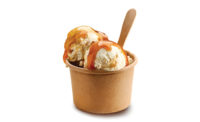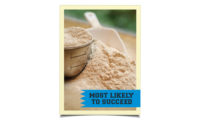Across food categories, consumers have made their demands clear — they want clean labels, more organic options and flavor variety. And manufacturers of cultured dairy have been answering this call. A diverse range of yogurts, cottage cheese and cream cheese products has hit the market in the last year, shining a light on this category’s versatility.
Milk | Cheese | Cultured | Ice Cream | Butter | Non-dairy Beverages | Ingredients | Exports
The versatility of yogurt (especially Greek yogurt) makes it an ideal ingredient in a variety of foods. Greek yogurt is used in dips and as a low-fat/high-protein replacement in cooking/baking. You can even find Greek yogurt-covered raisins and other dried fruits. Using sour cream and cream cheese in dips and cooking is nothing new, but combining it with Greek yogurt forms a nice hybrid to cut fat and add protein.
Meanwhile, kefir and cottage cheese strive to be the new stars in cultured dairy. More yogurt processors are making kefir, a fermented milk drink that’s high in probiotics. Kefir offers another option for consumers looking for on-the-go nutrition. And companies such as Good Culture Cottage Cheese, Irvine, Calif., are shining a spotlight on long-struggling cottage cheese as they try to reinvigorate that category with unique flavors and single-serve options.
“We continue to see dairy products like cottage cheese and yogurt launching innovative sweet and savory flavor varieties, while continuing to amplify their products nutritional offerings. This is especially true for anything that is single-serve that consumers can grab on the go,” said Gerard Meyer, CEO for Muuna, New York, another producer of single-serve flavored cottage cheeses. “We know our customers are eating smaller meals and something like cottage cheese that has high protein content will help to keep them full longer.”
A look at the numbers
The yogurt category’s sales have struggled of late, according to data from Chicago-based Information Resources Inc. (IRI). Dollar sales dropped 1.9% to $7.5 million, and unit sales decreased 8.2% to 4.7 billion, for the 52 weeks ending Aug. 6, 2017. The cottage cheese category also saw declines — dollar sales dipped 3.3% to $1.1 billion, and unit sales were down 1.3% to 431.7 million.
On the other hand, the cream cheese and sour cream categories saw slight increases. The cream cheese category’s dollar sales rose 3.8% to $1.7 billion, but unit sales were at a standstill (662.8 million), according to IRI. The sour cream category’s dollar sales increased 1.7% to $1.2 billion, and unit sales were up 0.9% to 624.5 million. Meanwhile, the smaller kefir segment showed real promise. Dollar sales were up 4% to $118 million, and unit sales jumped 5.1% to 37.1 million. See the table, this page.
Yogurt, kefir diversify
Now that the Greek yogurt craze has settled, plenty of other yogurt styles and concepts are vying for share of consumers’ stomachs. The biggest themes showing up are protein, whole milk, lower sugar, clean labels and convenience. Also of interest are probiotics, as well as grass-fed and lactose-free formulations.
“We’ve seen that Greek yogurt has been declining more quickly than the overall yogurt category, as large brands decline and newer launches, largely from bigger companies, were discontinued,” said Heidi Krauss, vice president of marketing and business development for siggi’s dairy, New York. “However, drinkable yogurts and whole-milk yogurts are outpacing category growth. We think the key to getting the category growing again is to get the assortment right, to give consumers more of the wholesome products they enjoy eating.”
Siggi’s, maker of Icelandic-style yogurt, added Triple Cream yogurts made with 9% milkfat to its line this year.
Lifeway Foods, Morton Grove, Ill., focuses a lot of attention on probiotics, from its kefir to its ProBugs line. ProBugs includes squeezable pouches of whole-milk kefir and Bites, freeze-dried kefir melts for children 9 months and older. Each 4-ounce pouch or serving of bites has 10 live and active probiotic cultures.
Lifeway also added several on-the-go options to its portfolio, including more 8-ounce bottles of kefir, which now have packaging to match the 32-ounce bottles. It also strained its drinkable kefir into 5.3-ounce cups for a spoonable snack. The kefir comes in a variety of flavors, in organic and conventional options. In addition, the company’s farmer cheese, which was available only as a multi-serve item, now comes blended with real fruit in single-serve cups.
Julie Smolyansky, CEO of Lifeway Foods, said the farmer cheese is similar to cottage cheese with the spreadable quality of cream cheese.
“Innovation has always driven growth in the yogurt category, and that is still the case today,” said Michael J. Neuwirth, senior director, external communication, DanoneWave, White Plains, N.Y. “Today, plant-based, organic, drinkables, kefirs and whole-milk varieties [are driving growth].”
DanoneWave had several launches in these areas this year, including Activia Lactose-Free and non-dairy Silk almond milk yogurt. On the organic side, it introduced a whole-milk line of Horizon Organic yogurt cups and tubs. And its Wallaby Organic brand added new seasonal pumpkin Greek yogurt and whole-milk Greek yogurt varieties.
Tillamook County Creamery Association, Tillamook, Ore., revamped its Good & Creamy yogurts to contain 9 grams of protein per 6-ounce serving. It also launched Farmstyle Whole Milk Greek in a variety of unique flavors, including strawberry black currant, raspberry fig and Meyer lemon pear.
A new functional Greek yogurt product from Mopro Nutrition LLC, Birmingham, Mich., takes protein to a new level. The whole-milk Greek yogurt is infused with CFM (cross-flow microfiltration method) whey protein isolate (WPI). It’s the first pre-made product to use CFM WPI, according to Michael Moran, founder/CEO of Mopro. CFM is a natural, non-chemical process that uses proprietary membrane techniques to create a highly pure (>90%), nutritionally superior and undenatured WPI, according to Mopro.
The yogurt is also very low in sugar and contains probiotics. A 5.3-ounce serving of the vanilla flavor contains 250 calories, 13 grams of fat, 4 grams of sugar (1 added) and 24 grams of protein.
“We are unique in the fact that we are a dairy product, but we are going after the fitness market to try to replace protein bars/shakes,” Moran said. “We seek to become the bridge between the food and supplement segments.”
Flavor innovation
Flavor varieties that include savory, spicy/sweet flavor combinations and unique sidecar inclusions are also pushing innovation in the category.
Koel Thomae, co-founder of noosa yoghurt, Bellvue, Colo., attributes more flavor innovation to yogurt’s increase in eating occasions.
“You’re starting to see more sweet, indulgent flavors that could substitute as a dessert and more savory flavors that can serve as lunch or snack replacements,” she explained. “This goes hand-in-hand with innovative flavor development. Everything from savory to salty-meets-sweet, to pairing sweet with a little bit of heat (like our blackberry serrano flavor), lends itself to different dayparts.”
This summer, noosa expanded its portfolio with noosa mates, mix-in-style yogurts that are paired with toppings like crunchy granolas, roasted nuts, pretzels and dark chocolate. Flavor varieties include honey cranberry almond (granola, cranberries, roasted almonds and pepitas) and honey pretzel peanut and maple ginger (granola, gingersnap streusel and candied ginger). The packaging features mix-ins in a separate clear cup on top of the yogurt.
“There’s more of a culinary edge to yogurt today than there was in years past, and that’s a good thing,” added Thomae.
Norwich, N.Y.-based Chobani, another company that focuses a lot on flavor development, added several varieties to its popular Flip line (yogurt with a side compartment for inclusions). Some of those flavors include Cinnamon Bun Fun (cinnamon low-fat yogurt with pastry crumbles, caramels and cinnamon roasted pecans), S’More S’Mores (vanilla low-fat yogurt with honey craham crackers, milk chocolate and toasted sugar bits) and breakfast-inspired varieties such as Sunrisin’ Raisin (raisin brown sugar nonfat yogurt with bran flakes, walnuts and honey praline pumpkin seeds).
The Greek Gods, a brand of The Hain Celestial Group, Lake Success, N.Y., launched a line called Seriously Indulgent that features a custard-like yogurt made with whole milk and cream. The yogurt features fruit on the bottom and comes in four flavors: lemon, marionberry, raspberry ginger and tart cherry.
Yogurt on-the-go
As mentioned, drinkable varieties of yogurt, usually in the form of smoothies, continue to gain popularity across the category.
DanoneWave’s Neuwirth said, “While growth in the traditional yogurt category has slowed due to the stabilization of Greek yogurt and the underperformance by a few yogurt makers, we are seeing growth in the drinkables format.”
To answer that call, the company launched Danimals squeezables and tubes for children. A 3.5-ounce squeezable pouch of the strawberry variety contains 12 grams of sugar and 4 grams of protein. The company also makes Oikos yogurt drinks (launched last year), which are available in four flavors. A 7-ounce serving of the vanilla flavor contains 10 grams of protein.
Chobani also expanded its yogurt drink line this year with flavors such as orange & cream, cherry vanilla and coffee & cream. The company now features 11 varieties of drinkable yogurt. A 10-ounce serving of its strawberry-banana flavor contains 14 grams of protein.
Stuyvesant, N.Y.-based Maple Hill Creamery added coffee, strawberry and mango peach flavors to its whole-milk 100% grass-fed drinkable yogurt line. The strawberry flavor contains 13 grams of protein per 12-ounce serving. And Siggi’s launched single-serve, whole-milk drinkable yogurts in three flavors: vanilla, strawberry and blueberry. The strawberry flavor contains 8 grams of protein per 8-ounce serving.
Dreaming Cow, Pavo, Ga., pushed the envelope further for drinkables by introducing Lush, a line of whole-milk, grass-fed yogurt drinks that contain a full serving of vegetables per 12-ounce bottle. Flavor varieties include strawberry, raspberry, purple carrot and beet; and peach, ginger, pumpkin and carrot. A 12-ounce serving of the former variety contains 11 grams of protein. The drinks also contain probiotics.
Keep it clean, focus on protein
Many of the processors we spoke with believe a crucial area to help spur growth in the cultured dairy category is focusing on clean ingredients and high protein content. And many companies are innovating or upgrading packaging to call out these details.
“Now more than ever, consumers are demanding better products with better ingredients. We believe every food maker has a responsibility to provide people with better options,” said Michael Gonda, vice president of corporate communications and public affairs at Chobani.
Chobani launched its first traditional (non-Greek) yogurt line called Smooth this summer. The company said it was looking to fill a need for more traditional yogurt with better ingredients, lower sugar and higher protein. Smooth is all natural, made without any artificial ingredients. The strawberry flavor contains 120 calories,
1.5 grams of fat, 14 grams of sugar and 11 grams of protein per 5.3-ounce serving.
Other companies that were already making products with lower sugar and clean labels are making their voices heard.
“Icelandic Provisions skyr has always been high-protein, with clean ingredients and non-GMO,” said Steve Platt, CEO, Icelandic Provisions, New York. “While everyone is scrambling to reformulate or innovate, skyr has been that way for about a thousand years.”
The company added Key Lime and cherry black currant (hitting stores early 2018) flavors to its lineup. It also updated its packaging with a new look, which can be found in stores at the end of November. The new design features a brighter white/light blue cup, with easy-to-find protein and sugar content call outs.
“People are starting to realize that most yogurts have a ton of sugar and additives in their product. Progressive retailers are bringing in smaller, more premium brands that meet consumers’ demand for a clean, healthier choice,” Platt noted.
Good Culture Cottage Cheese also recently updated its packaging to what it calls a more “modern design” and added organic mango and all-natural peach flavors to its lines. In addition, the company expanded its flavored cottage cheese line this past summer to include a natural range. Its original line is organic. The single-serve cottage cheeses are made with natural ingredients (no gums, preservatives, protein concentrates or artificial ingredients.) Both the organic and natural lines are made with whole milk from grass-fed cows.
“As the plant-based category continues to grow, the dairy industry needs to do a better job educating consumers on the benefits of nutrient-dense, high-quality protein dairy products,” noted Jesse Merrill, CEO and co-founder of Good Culture. “Consumers want to know that they are consuming products from healthy animals that live on pasture and eat grass. We need more farms to transition to this environment to make 100% grass-fed more accessible.”
Eric Snowdeal, senior brand manager at Organic Valley, La Farge, Wis., noted a proliferation of all-things grass-fed. This year, Organic Valley launched 100% grass-fed yogurts in 6-ounce cups and recently added a black cherry flavor.
“We continue to see products with grass-fed claims growing faster than organic and the overall category as a whole,” he said.
Don Stohrer, CEO of Arla Foods USA, Basking Ridge, N.J., believes consumers are looking further than just cleaner ingredients.
“I think that [clean label] now extends beyond the ingredient statement, as consumers are looking to seek out companies and brands for their principles — how they go about their business,” Stohrer said.
Looking beyond yogurt
Manufacturers of cream cheese, sour cream and cottage cheese have been focusing on innovations in snacking and convenience through unique packaging and concepts. There are also new creative flavor combinations.
In August, Arla launched a new format — cream cheese in squeeze tubes. Designed for, as the company put it, “busy moms,” the cream cheese comes in plain and strawberry flavors and is sold in 6.2-ounce squeezable bottles.
Meanwhile, The Kraft Heinz Co., Chicago, launched two innovative snacks involving cream cheese under its Philadelphia brand. Its bagel chips and cream cheese dips feature a two-compartment package with multigrain bagel chips on one side and flavored cream cheese on the other. The four flavors include brown sugar & cinnamon and garden vegetable. Its cheesecake cups also utilize the two-compartment cup — one side for cream cheese and one for a fruit or dessert topping to mix in. The four flavors are: strawberry, salted caramel, cherry and milk chocolate.
Darigold, Seattle, introduced a reduced-fat sour cream (available in 16- and 24-ounce tubs). The packaging boasts a “pure & simple” callout, playing up the clean ingredient angle. The sour cream contains 3.5 grams of fat per 2 tablespoons; its whole-milk counterpart has 6 grams of fat per the same serving size.
On the cottage cheese side, Kraft Heinz updated its packaging for its Breakstone’s Cottage Doubles and Knudsen Cottage Doubles lines, creating a more convenient single-serve two-compartment cup, and also added two flavors. Each package features a flavor mix-in on one side and cottage cheese in the other compartment. The two new flavors are mango habanero and honey vanilla.
La Terra Fina, Union City, Calif., focused on flavor innovation with new releases such as Sriracha Three Cheese Dip, Green Chile & Cheese Dip and Lemon Pepper & Asiago Dip. The dips are made with cream cheese and contain no artificial preservatives. La Terra Fina recently launched a full rebranding of its entire line, according to Stephanie Robbins, director of brand development for the company. The packaging now includes a stamp that says “Real Quality Food, Since 1983.” The packaging also includes new colorful images of ingredients.
Going forward
While many are looking for the “next Greek yogurt,” said Lifeway’s Smolyansky, “it could end up being a variety of products that help to fulfill consumers’ [search] for the next big thing. Skyr, farmer cheese, lassi ... cultured dairy takes many forms, and I think we’ll continue to see more exciting, innovative offerings.”
Milk | Cheese | Cultured | Ice Cream | Butter | Non-dairy Beverages | Ingredients | Exports








